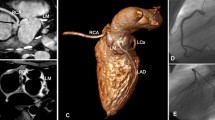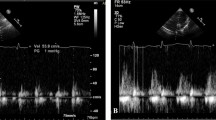Abstract
Dextro-transposition of the great arteries (D-TGA) is one of the most common cyanotic heart lesions. The arterial switch operation (ASO) is the preferred surgical palliation for D-TGA. One of the primary concerns following the ASO is complications arising from the coronary artery transfer. There is a need for myocardial perfusion assessment within ASO patients. There is no report on the utility of regadenoson as a stress agent in children following ASO. Our objective was to observe the safety and feasibility of regadenoson as a pharmacologic stressor for perfusion cardiac MR in a pilot cohort of pediatric and young-adult patients who have undergone ASO. We reviewed our initial experience with regadenoson stress cardiac MR in 36 pediatric and young-adult patients 15.1 ± 4.5 years (range 0.2–22 years) with history of ASO. The weight was 61.6 ± 21.5 kg (range 3.8–93 kg). All patients underwent cardiac MR because of concern for ischemia. Subjects’ heart rate and blood pressure were monitored and pharmacologic stress was induced by injection of regadenoson. We evaluated their hemodynamic response and adverse effects using changes in vital signs and onset of symptoms. A pediatric cardiologist and radiologist qualitatively assessed myocardial perfusion and viability images. All stress cardiac MR examinations were completed without adverse events. Resting heart rate was 72 ± 13 beats per minute (bpm) and rose to peak of 120 ± 17 bpm (95 ± 50% increase, p < 0.005) with regadenoson. Image quality was considered good or diagnostic in all cases. A total of 11/36 (31%) patients had a perfusion defect on the stress FPP images. 14 of the 36 patients (39%) underwent cardiac catheterization within 6 months of the CMR and the findings showed excellent agreement. Regadenoson may be a useful coronary hyperemia agent to utilize for pediatric patients following arterial switch procedure when there is concern for ischemia. The ability to administer as a single bolus with one IV makes it advantageous in pediatrics. In a limited number of cases, regadenoson stress perfusion showed excellent agreement with cardiac catheterization.





Similar content being viewed by others
Abbreviations
- d-TGA:
-
Dextro-transposition of the great arteries
- ASO:
-
Arterial switch operation
- CMR:
-
Cardiac magnetic resonance imaging
- FPP:
-
First-pass perfusion
- IV:
-
Intravenous
- FFR:
-
Fractional flow reserve
- ECG:
-
Electrocardiogram
- EPI:
-
Echo planar imaging
- SSFP:
-
Steady-state free precession
References
Gatzoulis MA, Graham TP Jr (2003) International Society for Adult Congenital Cardiac Disease: an introduction to the readership and an invitation to join. Int J Cardiol 88(2–3):127–128
Blume ED et al (1999) Evolution of risk factors influencing early mortality of the arterial switch operation. J Am Coll Cardiol 33(6):1702–1709
Villafane J et al (2014) D-transposition of the great arteries: the current era of the arterial switch operation. J Am Coll Cardiol 64(5):498–511
Legendre A et al (2003) Coronary events after arterial switch operation for transposition of the great arteries. Circulation 108(Suppl 1):II186–II190
Pasquali SK et al (2002) Coronary artery pattern and outcome of arterial switch operation for transposition of the great arteries: a meta-analysis. Circulation 106(20):2575–2580
Pizzi MN et al (2014) Long-term follow-up assessment after the arterial switch operation for correction of dextro-transposition of the great arteries by means of exercise myocardial perfusion-gated SPECT. Pediatr Cardiol 35(2):197–207
Lim HG et al (2013) Long-term results of the arterial switch operation for ventriculo-arterial discordance. Eur J Cardiothorac Surg 43(2):325–334
Tanel RE et al (1995) Coronary artery abnormalities detected at cardiac catheterization following the arterial switch operation for transposition of the great arteries. Am J Cardiol 76(3):153–157
Bonnet D et al (1996) Long-term fate of the coronary arteries after the arterial switch operation in newborns with transposition of the great arteries. Heart 76(3):274–279
Hauser M et al (2001) Myocardial blood flow and flow reserve after coronary reimplantation in patients after arterial switch and Ross operation. Circulation 103(14):1875–1880
Schwitter J et al (2013) MR-IMPACT II: Magnetic Resonance Imaging for Myocardial Perfusion Assessment in Coronary artery disease Trial: perfusion-cardiac magnetic resonance vs. single-photon emission computed tomography for the detection of coronary artery disease: a comparative multicentre, multivendor trial. Eur Heart J 34(10):775–781
Greenwood JP et al (2012) Cardiovascular magnetic resonance and single-photon emission computed tomography for diagnosis of coronary heart disease (CE-MARC): a prospective trial. Lancet 379(9814):453 – 60
Prakash A et al (2004) Magnetic resonance imaging evaluation of myocardial perfusion and viability in congenital and acquired pediatric heart disease. Am J Cardiol 93(5):657–661
Buechel ER et al (2009) Feasibility of perfusion cardiovascular magnetic resonance in paediatric patients. J Cardiovasc Magn Reson 11:51
Ntsinjana HN et al. (2016) Utility of adenosine stress perfusion CMR to assess paediatric coronary artery disease. Eur Heart J Cardiovasc Imaging 18(8):898–905
Tacke CE et al (2011) Cardiac magnetic resonance imaging for noninvasive assessment of cardiovascular disease during the follow-up of patients with Kawasaki disease. Circ Cardiovasc Imaging 4(6):712–720
Al Jaroudi W, Iskandrian AE (2009) Regadenoson: a new myocardial stress agent. J Am Coll Cardiol 54(13):1123–1130
Nguyen KL et al (2014) Safety and tolerability of regadenoson CMR. Eur Heart J Cardiovasc Imaging 15(7):753–760
Vasu S et al (2013) Regadenoson and adenosine are equivalent vasodilators and are superior than dipyridamole- a study of first pass quantitative perfusion cardiovascular magnetic resonance. J Cardiovasc Magn Reson 15:85
Noel CV et al (2017) Myocardial stress perfusion magnetic resonance: initial experience in a pediatric and young adult population using regadenoson. Pediatr Radiol 47(3):280–289
Pijls NH, van Nunen LX (2015) Fractional flow reserve, maximum hyperemia, adenosine, and regadenoson. Cardiovasc Revasc Med 16(5):263–265
Noel CV et al (2016) Myocardial stress perfusion magnetic resonance: initial experience in a pediatric and young adult population using regadenoson. Pediatr Radiol 47(3):280–289
Gordi T et al (2006) A population pharmacokinetic/pharmacodynamic analysis of regadenoson, an adenosine A2A-receptor agonist, in healthy male volunteers. Clin Pharmacokinet 45(12):1201–1212
Tsuda E et al (1992) Late death after arterial switch operation for transposition of the great arteries. Am Heart J 124(6):1551–1557
Kirklin JW et al (1992) Clinical outcomes after the arterial switch operation for transposition. Patient, support, procedural, and institutional risk factors. Congenit Heart Surg Soc Circ 86(5):1501–1515
Brown JW, Park HJ, Turrentine MW (2001) Arterial switch operation: factors impacting survival in the current era. Ann Thorac Surg 71(6):1978–1984
Haeffele C, Lui GK (2015) Dextro-transposition of the great arteries: long-term sequelae of atrial and arterial switch. Cardiol Clin 33(4):543–558
Kempny A et al (2013) Outcome in adult patients after arterial switch operation for transposition of the great arteries. Int J Cardiol 167(6):2588–2593
Metton O et al (2010) Intramural coronary arteries and outcome of neonatal arterial switch operation. Eur J Cardiothorac Surg 37(6):1246–1253
Wong SH et al (2008) Cardiac outcome up to 15 years after the arterial switch operation. Heart Lung Circ 17(1):48–53
Ou P et al (2013) Mechanisms of coronary complications after the arterial switch for transposition of the great arteries. J Thorac Cardiovasc Surg 145(5):1263–1269
Turner DR et al (2010) Coronary diameter and vasodilator function in children following arterial switch operation for complete transposition of the great arteries. Am J Cardiol 106(3):421–425
Tobler D et al (2014) Evaluation of a comprehensive cardiovascular magnetic resonance protocol in young adults late after the arterial switch operation for d-transposition of the great arteries. J Cardiovasc Magn Reson 16:98
Manso B et al (2010) Myocardial perfusion magnetic resonance imaging for detecting coronary function anomalies in asymptomatic paediatric patients with a previous arterial switch operation for the transposition of great arteries. Cardiol Young 20(4):410–417
Mahmarian JJ et al (2009) Regadenoson induces comparable left ventricular perfusion defects as adenosine: a quantitative analysis from the ADVANCE MPI 2 trial. JACC Cardiovasc Imaging 2(8):959–968
Cerqueira MD et al (2008) Effects of age, gender, obesity, and diabetes on the efficacy and safety of the selective A2A agonist regadenoson versus adenosine in myocardial perfusion imaging integrated ADVANCE-MPI trial results. JACC Cardiovasc Imaging 1(3):307–316
Funding
No funding was utilized for this retrospective review.
Author information
Authors and Affiliations
Contributions
CVN was responsible for project concept design, image analysis, and manuscript formation. RK was responsible for project design and manuscript formation and revision. PM was responsible for image analysis, manuscript formation, and revision. BM was responsible for regadenoson analysis, administration, and recommendations. TS was responsible for image analysis, manuscript formation, and revision. RK was responsible for project concept design, project objectives, and manuscript revision.
Corresponding author
Ethics declarations
Conflict of interest
The author declares that they have no conflict of interest.
Rights and permissions
About this article
Cite this article
Noel, C.V., Krishnamurthy, R., Masand, P. et al. Myocardial Stress Perfusion MRI: Experience in Pediatric and Young-Adult Patients Following Arterial Switch Operation Utilizing Regadenoson. Pediatr Cardiol 39, 1249–1257 (2018). https://doi.org/10.1007/s00246-018-1890-z
Received:
Accepted:
Published:
Issue Date:
DOI: https://doi.org/10.1007/s00246-018-1890-z




